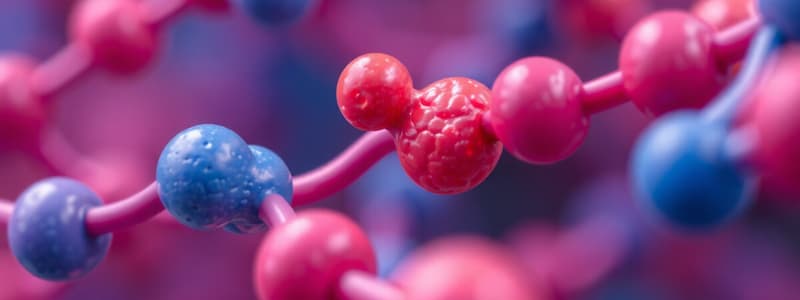Podcast
Questions and Answers
What does the term 'metabolism' specifically refer to?
What does the term 'metabolism' specifically refer to?
- The synthesis of proteins within cells
- Only the chemical reactions occurring in living cells
- The chemical reactions along with coordination, regulation, and energy requirements (correct)
- The total number of all cells in an organism
Which statement accurately describes what metabolites are?
Which statement accurately describes what metabolites are?
- The enzymes that facilitate chemical reactions
- The genetic material that codes for proteins
- Small molecule intermediates in the degradation and synthesis of polymers (correct)
- Large macromolecules that serve as the building blocks of cells
What does the term 'metabolite pool' refer to?
What does the term 'metabolite pool' refer to?
- The collection of all enzymes in a cell
- The number of cells participating in metabolism
- All substances involved in metabolic processes in a biological system (correct)
- The total energy consumed in metabolic reactions
How is the size of the metabolic pool within a cell described?
How is the size of the metabolic pool within a cell described?
Which of the following does not fall under the scope of metabolism?
Which of the following does not fall under the scope of metabolism?
What is the term used to describe a series of reactions with a specific purpose, such as glucose degradation or fatty acid synthesis?
What is the term used to describe a series of reactions with a specific purpose, such as glucose degradation or fatty acid synthesis?
Which of the following best describes a linear metabolic pathway?
Which of the following best describes a linear metabolic pathway?
In which type of metabolic pathway do the intermediates return to the start of the process following a circular route?
In which type of metabolic pathway do the intermediates return to the start of the process following a circular route?
Which option correctly identifies a characteristic of a spiral metabolic pathway?
Which option correctly identifies a characteristic of a spiral metabolic pathway?
Which of the following is not a type of metabolic pathway mentioned?
Which of the following is not a type of metabolic pathway mentioned?
What is the primary function of catabolic reactions?
What is the primary function of catabolic reactions?
Which of the following correctly describes anabolic reactions?
Which of the following correctly describes anabolic reactions?
How are catabolism and anabolism related?
How are catabolism and anabolism related?
What characterizes catabolic reactions in terms of energy?
What characterizes catabolic reactions in terms of energy?
What is one means by which anabolic reactions contribute to cellular processes?
What is one means by which anabolic reactions contribute to cellular processes?
What percentage of the human body mass is formed by the main elements, commonly represented by CHON?
What percentage of the human body mass is formed by the main elements, commonly represented by CHON?
Which of the following statements about the elements needed for living organisms is true?
Which of the following statements about the elements needed for living organisms is true?
What are trace elements and their significance in biological processes?
What are trace elements and their significance in biological processes?
Which of the following correctly identifies the total number of natural elements found in nature?
Which of the following correctly identifies the total number of natural elements found in nature?
How many of the total natural elements are typically not found in all living cells?
How many of the total natural elements are typically not found in all living cells?
What distinguishes essential elements from trace elements in the context of cellular composition?
What distinguishes essential elements from trace elements in the context of cellular composition?
Which of the following is classified as an organic compound found in cells?
Which of the following is classified as an organic compound found in cells?
Which statement about inorganic compounds is accurate in the context of cellular composition?
Which statement about inorganic compounds is accurate in the context of cellular composition?
Which category of compounds do carbohydrates, proteins, lipids, and nucleic acids belong to?
Which category of compounds do carbohydrates, proteins, lipids, and nucleic acids belong to?
What role does water play in the composition of the cell as an inorganic compound?
What role does water play in the composition of the cell as an inorganic compound?
Which of the following statements accurately describes an element?
Which of the following statements accurately describes an element?
Which of the following is not considered an essential element for living organisms?
Which of the following is not considered an essential element for living organisms?
Which of the following elements is categorized as a trace element?
Which of the following elements is categorized as a trace element?
What is true about chemical reactions involving elements?
What is true about chemical reactions involving elements?
Which of the following elements needs to be consumed in relatively larger amounts for proper functioning in living organisms?
Which of the following elements needs to be consumed in relatively larger amounts for proper functioning in living organisms?
What role does magnesium play in both animal and plant cells?
What role does magnesium play in both animal and plant cells?
Which element is involved in the synthesis of hemoglobin in animal cells?
Which element is involved in the synthesis of hemoglobin in animal cells?
Which function is specific to calcium in plant cells?
Which function is specific to calcium in plant cells?
What is the primary use of sodium in animal cells?
What is the primary use of sodium in animal cells?
Which element is not required in plant cells for the synthesis of chlorophyll?
Which element is not required in plant cells for the synthesis of chlorophyll?
Which function is associated with phosphorus (P) in animal cells?
Which function is associated with phosphorus (P) in animal cells?
What role does potassium (K) play in plant cells?
What role does potassium (K) play in plant cells?
What is a key role of chlorine (Cl) in animal cells?
What is a key role of chlorine (Cl) in animal cells?
Which of the following functions is performed by phosphorus (P) in plant cells?
Which of the following functions is performed by phosphorus (P) in plant cells?
What function of chlorine (Cl) occurs during photosynthesis in plant cells?
What function of chlorine (Cl) occurs during photosynthesis in plant cells?
What is a defining characteristic of organic compounds?
What is a defining characteristic of organic compounds?
Which of the following is an example of an inorganic compound?
Which of the following is an example of an inorganic compound?
Which statement accurately describes a compound?
Which statement accurately describes a compound?
Which of the following best describes inorganic compounds?
Which of the following best describes inorganic compounds?
Which of the following substances is not classified as an organic compound?
Which of the following substances is not classified as an organic compound?
Flashcards are hidden until you start studying
Study Notes
Metabolism
- Metabolism encompasses the entire network of chemical reactions in living cells, including coordination, regulation, and energy requirements.
- Metabolites are small molecule intermediates essential for the degradation and synthesis of larger polymeric molecules.
- The metabolite pool consists of all substances involved in metabolic processes within a biological system, acting as a reservoir for enzymatic reactions.
Metabolic Pathways
- Metabolic pathways are classified into two major types: catabolism and anabolism.
- Catabolic reactions break down larger molecules to produce smaller molecules and release energy.
- Anabolic reactions build larger molecules from smaller units for cell maintenance, growth, and reproduction.
- Catabolism is typified by oxidation reactions, releasing free energy converted to ATP, while anabolism involves reduction reactions utilizing energy stored in ATP.
- Catabolism and anabolism are interconnected, with catabolic processes harvesting energy from food, which is then used in anabolic processes.
Types of Metabolic Pathways
- Linear Pathways: Involve a sequential series of reactions, e.g., the degradation of glucose.
- Cyclic Pathways: Characterized by a circular sequence of reactions, e.g., the Krebs cycle involving intermediates such as Acetyl CoA and Citrate.
- Spiral Pathways: Represented by processes like fatty acid biosynthesis, where reactions spiral through intermediates.
Chemical Composition of the Cell
- Organisms are composed of about 25 essential elements from a total of approximately 92 naturally occurring elements.
- Main cellular elements are Carbon (C), Hydrogen (H), Oxygen (O), and Nitrogen (N), which collectively form 96% of human body mass.
- Trace elements exist in smaller quantities but are crucial for various biological functions.
Essential Elements
- Major essential elements include:
- Carbon (C), Hydrogen (H), Oxygen (O), Nitrogen (N), Calcium (Ca), Potassium (K), Phosphorus (P), Sulfur (S), Sodium (Na), Chlorine (Cl), and Magnesium (Mg).
- Essential elements are needed in large amounts for growth and survival.
Trace Elements
- Important trace elements include Copper (Cu), Iodine (I), and Iron (Fe), required in smaller quantities.
Functions of Elements in Cells
- Hydrogen (H), Carbon (C), Oxygen (O), Nitrogen (N): Fundamental for synthesizing organic compounds like proteins and nucleic acids.
- Sulfur (S): Integral to certain protein structures.
- Sodium (Na): Regulates osmotic pressure; not required in plant cells.
- Magnesium (Mg): Vital for nerve impulse transmission and acts as a cofactor for enzymes; necessary for chlorophyll synthesis in plants.
- Calcium (Ca): Essential for bone formation, muscle contraction, and blood clotting; contributes to cell wall synthesis in plants.
- Iron (Fe): Plays a critical role in hemoglobin synthesis and electron transport during photosynthesis and respiration.
Functions of Phosphorus and Potassium
-
Phosphorus (P):
- In animal cells, it supports bone health, muscle contraction, ATP synthesis, and serves as a nucleic acid component.
- In plant cells, it promotes flower and seed formation and aids cell division.
-
Potassium (K):
- Crucial for muscle contractions in animals, and in plants, it facilitates carbohydrate synthesis.
Compounds in Cells
- Organic Compounds: Comprising carbon and hydrogen, essential for life—includes carbohydrates, proteins, lipids, and nucleic acids.
- Inorganic Compounds: Lacking carbon and hydrogen, associated primarily with non-living elements, such as water.
Studying That Suits You
Use AI to generate personalized quizzes and flashcards to suit your learning preferences.




